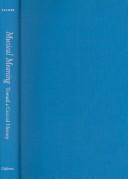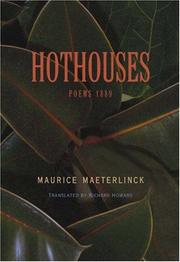| Listing 1 - 8 of 8 |
Sort by
|
Book
Year: 2009 Publisher: Roanne Musée de beaux-arts et d'archéologie J. Déchelette
Abstract | Keywords | Export | Availability | Bookmark
 Loading...
Loading...Choose an application
- Reference Manager
- EndNote
- RefWorks (Direct export to RefWorks)
Solar system --- Iconography --- iconography --- moonlight
Book
Abstract | Keywords | Export | Availability | Bookmark
 Loading...
Loading...Choose an application
- Reference Manager
- EndNote
- RefWorks (Direct export to RefWorks)
Painting --- History --- moonlight --- landscapes [representations] --- Rubens, Peter Paul --- anno 1600-1699 --- Flanders
Book
Year: 1968
Abstract | Keywords | Export | Availability | Bookmark
 Loading...
Loading...Choose an application
- Reference Manager
- EndNote
- RefWorks (Direct export to RefWorks)
Painting --- History --- moonlight --- Neer, van der, Aert --- anno 1600-1699 --- Netherlands
Book
Abstract | Keywords | Export | Availability | Bookmark
 Loading...
Loading...Choose an application
- Reference Manager
- EndNote
- RefWorks (Direct export to RefWorks)
moonlight --- nachtstuk --- Cupid [Mythological character] --- Elsheimer, Adam --- Venus [Mythological character] --- Sandrart, von, Joachim I
Book
ISBN: 9781032152066 9780367151393 1032152060 0367151391 Year: 2022 Publisher: Abingdon, Oxon ; New York, NY : Routledge,
Abstract | Keywords | Export | Availability | Bookmark
 Loading...
Loading...Choose an application
- Reference Manager
- EndNote
- RefWorks (Direct export to RefWorks)
"This book helps readers understand Moonlight's profound political and social importance, the innovative technical choices adopted by director Barry Jenkins, and the film's adoption and disruption of traditional coming-of-age themes through the specific prism of Chiron's childhood and youth. Moonlight (2016) is an intensely moving and poetically rendered coming-of-age story about a young gay Black boy, Chiron. Highly praised by both critics and audiences internationally, it garnered a surprise Best Picture win at the 2017 Academy Awards, enshrining its significance within a global cinematic canon. This book provides an account of how Moonlight can be situated in relation to African American youth films, contemporary queer cinema and its appeal to youth market and representations of non-normative childhood and adolescence. It analyses the reception of Moonlight in terms of its form and profound emotional impact on spectators offering new visions of African American boyhoods, while also contributing an extended exploration of the social and political context of the film in relation to Obama, Trump, and diversity in filmmaking. Highlighting to students and scholars the powerful emotional pull of Moonlight and why it is a highly significant film, this book is ideal for those interested in critical race studies, queer theory, youth cinema, African American cinema, and LGBTQ cinema"--

ISBN: 0520928326 0585466246 9780520928329 9780585466248 0520228243 9780520228245 0520232720 9780520232723 Year: 2002 Publisher: Berkeley ; London : University of California Press,
Abstract | Keywords | Export | Availability | Bookmark
 Loading...
Loading...Choose an application
- Reference Manager
- EndNote
- RefWorks (Direct export to RefWorks)
Lawrence Kramer has been a pivotal figure in the development of the controversial new musicology, integrating the study of music with social and cultural issues. This accessible and eloquently written book continues and deepens the trajectory of Kramer's thinking as it boldly argues that humanistic, not just technical, meaning is a basic force in music history and an indispensable factor in how, where, and when music is heard. Kramer draws on a broad range of music and theory to show that the problem of musical meaning is not just an intellectual puzzle, but a musical phenomenon in its own right. How have romantic narratives involving Beethoven's "Moonlight" Sonata affected how we hear this famous piece, and what do they reveal about its music? How does John Coltrane's African American identity affect the way we hear him perform a relatively "white" pop standard like "My Favorite Things"? Why does music requiring great virtuosity have different cultural meanings than music that is not particularly virtuosic? Focusing on the classical repertoire from Beethoven to Shostakovich and also discussing jazz, popular music, and film and television music, Musical Meaning uncovers the historical importance of asking about meaning in the lived experience of musical works, styles, and performances. Kramer's writing, clear and full of memorable formulations, demonstrates that thinking about music can become a vital means of thinking about general questions of meaning, subjectivity, and value. In addition to providing theoretical advances and insights on particular pieces and repertoires, Musical Meaning will be provocative reading for those interested in issues of identity, gender, and cultural theory. This book includes a CD of Kramer's own composition, Revenants: 32 Variations in C Minor, which he discusses in his final chapter.
Music --- Music, Influence of. --- Subjectivity in music. --- Music, Effect of --- Hermeneutics (Music) --- Musical aesthetics --- Aesthetics --- Music theory --- Criticism --- History and criticism. --- Philosophy and aesthetics. --- Philosophy --- academic. --- accessible. --- beethoven. --- composers. --- cultural history. --- cultural issues. --- cultural theory. --- easy to understand. --- famous composer. --- gender studies. --- humanist. --- humanistic. --- identity. --- moonlight sonata. --- music culture. --- music history. --- music performance. --- musical composition. --- musical genres. --- musicology. --- scholarly. --- social history. --- social issues.
Book
ISBN: 9783735602619 Year: 2016 Publisher: Bielefeld Kerber
Abstract | Keywords | Export | Availability | Bookmark
 Loading...
Loading...Choose an application
- Reference Manager
- EndNote
- RefWorks (Direct export to RefWorks)
Art --- letters [correspondence] --- photographs --- sculpture [visual works] --- installations [visual works] --- astronomy --- light [energy] --- sound [acoustics] --- light art --- woods [plant communities] --- time --- motion pictures [visual works] --- mixed media --- fossils --- stars [motifs] --- meteorites --- libraries [institutions] --- wood [plant material] --- moonlight --- sound art --- toekomst (kunst) --- kunst en wetenschap --- Paterson, Katie

ISBN: 0691088381 0691088373 0691222428 Year: 2003 Publisher: Princeton, N.J. ; Oxford : Princeton University Press,
Abstract | Keywords | Export | Availability | Bookmark
 Loading...
Loading...Choose an application
- Reference Manager
- EndNote
- RefWorks (Direct export to RefWorks)
On May 31, 1889, a young Belgian lawyer from a wealthy bourgeois family in Ghent published a book of 33 poems in 155 copies. Maurice Maeterlinck's legal career was floundering but his road to literary greatness had begun. Long overshadowed by the plays that later won him the Nobel Prize, Serres chaudes (Hothouses) nonetheless came to be widely regarded as one of the cornerstones of literary Modernism after Baudelaire. While Max Nordau soon seized upon Maeterlinck's--tumult of images--as symptomatic of a pervasive social malaise, decades later Antonin Artaud pronounced, "Maeterlinck was the first to introduce the multiple riches of the subconscious into literature." Richard Howard's translation of this quietly radical work is the first to be published in nearly a century, and the first to accurately convey Maeterlinck's elusive visionary force. The poems, some of them in free verse (new to Belgium at the time), combine the decadent symbolism and the language of dislocation that Maeterlinck later perfected in his dramas. Hothouses reflects the influence not only of French poets including Verlaine and Rimbaud, but also of Whitman. As for the title, the author said it was "a natural choice, Ghent . . . abounding in greenhouses." The poems, whose English translations appear opposite the French originals, are accompanied by reproductions of seven woodcuts by Georges Minne that appeared in the original volume, and by an early prose text by Maeterlinck imaginatively describing a painting by the sixteenth-century Flemish artist Pieter Brueghel. A feat of daring power extraordinarily immediate and inventive, Hothouses will appeal to all lovers of poetry, and in particular to those interested in Modernism. Maeterlinck's enormous fame may have faded, but twentieth-century writers such as Beckett are still our masters who testify to its undying influence.
Dutch literature --- Poetry, Modern --- Poetry --- Chasses Lasses. --- Dim Hours. --- Ennui. --- Entreaty. --- Examinez. --- Fauves Las. --- Fevered Souls. --- God. --- Heures Ternes. --- Hothouse. --- Humble Offering. --- Lassitude. --- Monotonement. --- Offrande Obscure. --- Oraison. --- Prayer. --- Regarde. --- Serre Chaude. --- Tedium. --- Weary Beasts. --- Weary Hunting. --- ambulance. --- asylum. --- blanches. --- bringing. --- compromising. --- endormies. --- endormis. --- eternally frozen. --- famine. --- festival. --- immemorial storms. --- impuissante. --- malade. --- mensonges. --- moonlight. --- obscures. --- perpetually. --- purple snakes. --- quagmires roses. --- sadness. --- sentinelles. --- sopping woods. --- souffles. --- suburbs. --- suffocated. --- symboles. --- temptations. --- tristement. --- vainement. --- vraiment. --- warmest corners. --- Poetry. --- POETRY / European / General. --- Poems --- Verses (Poetry) --- Literature --- Philosophy
| Listing 1 - 8 of 8 |
Sort by
|

 Search
Search Feedback
Feedback About UniCat
About UniCat  Help
Help News
News